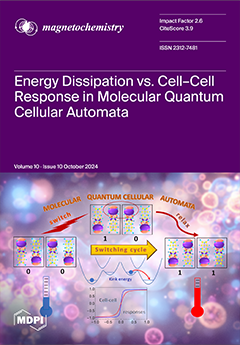The chemistry of heterometallic metal complexes continues to attract the interest of molecular inorganic chemists mainly because of the properties that different metal ions can bring to compounds. Contrary to the plethora of 3d–4f- and 3d–3d′-metal complexes, complexes containing both 3d- and 4d-metal ions are much less studied. The choice of the bridging organic ligand is of paramount importance for the synthesis of such species. In the present work, we describe the use of the potentially tetradentate NOO′O″ Schiff bases
N-(2-carboxyphenyl)salicylideneimine (saphHCOOH) and
N-(4-chloro-carboxyphenyl)salicylideneimine (4ClsaphHCOOH) in Cd
II-M
III (M = Fe, Cr) chemistry. The complexes [Cd
2Fe
2(saphCOO)
4(NO
3)
2(H
2O)
2] (
1), [Cd
2Cr
2(saphCOO)
4(NO
3)
2(H
2O)
2] (
2), [Cd
2Fe
2(4ClsaphCOO)
4(NO
3)
2(H
2O)
2] (
3) and [CdCr
2(4ClsaphCOO)
4(H
2O)
3(EtOH)] (
4) have been structurally characterized, the quality of the structure of the latter being poor but, permitting the knowledge of the connectivity and the main structural features. Complexes
1–
3 are isostructural, but not isomorphous, possessing a variety of lattice solvent molecules (EtOH, MeCN, CH
2Cl
2, H
2O). The metal topology can be described as two isosceles triangles sharing a common Cd
II…Cd
II edge. The two Cd
II atoms are doubly bridged by two μ-aqua groups. The M
III…Cd
II sides of the triangles are each asymmetrically bridged by one carboxylate oxygen atom of a 2.2111 saphCOO
2−/4ClsaphCOO
2− ligand. The core of the molecules is {Cd
2M
2(μ-O
aqua)
2(μ-OR)
4}
6+, where the OR oxygen atoms are the bridging carboxylate oxygens. The coordination spheres of the metal ions in the centrosymmetric molecules are [Cd(O
aqua)
2(O
carboxylato)
4(O
nitrato)
2] and [M(N
imino)
2(O
carboxylato)
2(O
phenolato)
2]. The biaugmented trigonal prism is the most appropriate for the description of the coordination geometry of the Cd
II atoms in
1 and
3, while the geometry of these metal ions in
2 is best described as distorted triangular dodecahedral. A combination of H-bonding and π–π stacking interactions give interesting supramolecular patterns in the three tetranuclear compounds. The three metal ions in
4 define an isosceles triangle with two almost equal Cd
II…Cr
III sides. The Cd
II center is linked to each Cr
III atom through one carboxylato oxygen of a 2.2111 4ClsaphCOO
2− ligand. The core of the molecule is {CdCr
2(μ-OR)
2}
6+, where the OR oxygen atoms are the bridging carboxylato oxygens. A tridentate chelating 1.1101 4ClsaphCOO
2− ligand is bonded to each Cr
III. The coordination spheres are [Cd(O
aqua)
3(O
ethanol)(O
bridging carboxylato)
2(O
terminal carboxylate)
2] and [Cr(O
bridging carboxylato)(O
terminal carboxylato)(O
phenolato)
2(N
imino)
2]. Complexes
1–
4 are the first heterometallic 3d–4d complexes based on saphHCOOH and 4ClsaphCOOH. The structures are critically compared with those of previous reported Zn
II-M
III (M = Fe, Cr) complexes. The IR and Raman spectra of the complexes are discussed in terms of the coordination modes of the ligands involved. UV/VIS spectra in CH
2Cl
2 are also reported, and the bands are assigned to the corresponding transitions. The
δ and Δ
EQ57Fe-Mössbauer parameters of
1 and
3 at room temperature and 80 K suggest the presence of isolated high-spin Fe
III centers. Variable-temperature (1.8–310 K) and variable-field (0–50 kOe) magnetic studies for
1 and
2 indicate the absence of M
III…M
III exchange interactions, in agreement with the long distances (~8 Å) between the paramagnetic metal ions. The combined work demonstrates the ability of saphCOO
2− and 4ClsaphCOO
2− to give 3d–4d metal complexes.
Full article





